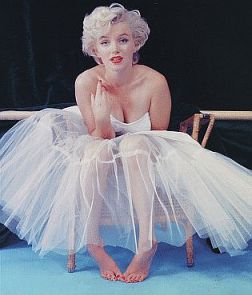Blond
|
|

Blond (feminine, blonde) is a hair colour found in certain mammals characterised by low levels of the dark pigment eumelanin and higher levels of the pale pigment phæomelanin, in common with red or ginger hair. The resultant visible hue depends on various factors, but always has some sort of yellowish colour, going from the very pale blond caused by a patchy, scarce distribution of pigment, to reddish "strawberry" blond colours or golden brownish blond colours, the latter with more eumelanin.
Blond hair can be found among certain races of humans and breeds of dogs and cats, among other mammalian species.
| Contents |
Etymology, spelling, and grammar
The adjective is a relatively recent borrowing into English from French (the traditional English terms for blond being "fair-haired", "flaxen", or "tow-haired"), and careful writers still distinguish between the masculine blond and the feminine blonde. However, most people do not borrow French's system of grammatical gender along with the word or confuse the two, the tendency being for North Americans to use the masculine in either case, and other English-speakers to use the feminine in either case. The feminine is also used as a noun meaning "a blonde woman or girl". The French word, in turn, derives from the medieval Latin blondus or blundus, meaning yellow.
The word—with one spelling or the other—is also occasionally used to refer to objects that have a colour reminiscent of fair hair. Examples include dolls' hair, pale wood, and lager beer.
Distribution among humans
Fair hair is characteristic of the peoples of Northern Europe, particularly Scandinavia (very pale hair is often referred to as Nordic blond.). It is genetically associated with paler eye-colour (blue and green) and pale (sometimes freckled) skin tone. However, red and brown hair is also very common in these regions; and, conversely, there is a small minority of blond people even among dark-skinned populations in places such as North Africa, the Middle East, and a few amongst Australian Aborigines. By percentage, it varies from less than 5% in North Africa and the Middle East (including Iran and Afghanistan), to about 10% in Southern Europe, to 35% in Northern Europe (such as Germany, Ireland, Poland and Britain), to over 50% in the Nordic countries. In mestizo countries in Latin America such as Mexico and Colombia, it's about 1%; among Sub-saharan Africans and East Asians, the distribution is very low; only about 1 in 1000, and is often associated with albinism.
It is also normal for hair to darken through childhood. Caucasian babies are generally born with the slightest wisp of fair hair, and then go on to grow hair of the colour that they are genetically programmed to grow. Darkening can even occur relatively late in life (greying of hair is a separate issue, though). Strong sunlight also lightens hair of any pigmentation, to varying degrees.
Instinctive and cultural reactions
Dark-haired people have historically found pale hair to be striking, and often wished to emulate it. The dark-haired women of Rome, for instance, used to buy wigs made from hair from the yellow- and red-haired Germanic tribespeople that their civilisation came into contact with. In modern Western culture, the bleaching of hair is common, especially among women.
Some research suggests that fair hair, being characteristic of young children, evokes parent-like feelings of affection and protection in others. This would explain the oft-noted association of blonde hair with prettiness and femininity, though fashions obviously also play a role. This association with children may also be the cause of the common Western stereotype against blonde women as being unintelligent (such as fictional character Chrissy Snow, a stereotypical dumb blonde). However, in the early twentieth century the opposite idea prevailed, blond hair being associated with an Aryan master race, promoted by Nordicists such as Madison Grant and Alfred Rosenberg.
Blonde children are often called "Towheads" because their hair color reminded people of bundles of flax.
See also
- blonde joke
- Aristasian blondes
External link
- American Heritage Book of English Usage (http://www.bartleby.com/64/C005/002.html), blond/blondede:Blond
